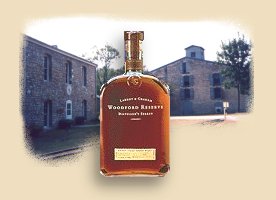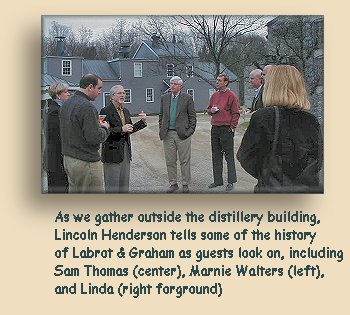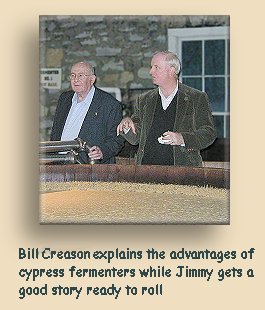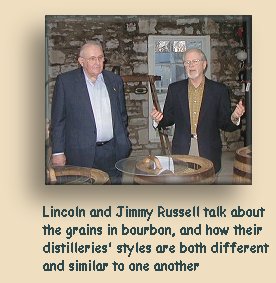American
Spirits
Labrot & Graham
Distillery
On July 29, 2000 Labrot & Graham hosted the inaugural dinner and reception
of the newly-formed Kentucky chapter of the American Institute of Wine and
Food at the distillery. The speaker and guest of honor was Julia Child. Building
upon the success of that evening, the distillery began sending invitations
and brochures to select customers and patrons, announcing a whole series
of special events, called the Bourbon & Bluegrass
Series, to be held later that year and into spring of 2001.
There would be a Christmas celebration, a bourbon and chocolate tasting,
cooking classes, and a series of Master Distiller’s Table events, the
first of which would be presented on Friday, February 23rd. Unlike the daily
distillery tours, these events are not free and, although open to the public,
are by reservation only. To learn more, call them at
1-859-879-1812 or write to
Labrot & Graham Distillery
THIS AFTERNOON WE LEAVE from our Lexington motel in what
we expect will be plenty of time to get to the Labrot & Graham distillery for
the special event beginning at 5:30 this evening. We thought we might take a
ride past Stone Castle, the Old Taylor distillery which is not far from Labrot &
Graham, to see if the antique shop there might still be open. The owner, Cecil
Withrow, passed away last December and we thought we might offer our condolences
to his wife. We drive to Versailles, but we just can’t find Elm Street, the road
that becomes McCracken Pike as it heads toward Glenn’s Creek. After driving out
the other side of Versailles and turning around, we drive back to the
intersection at the center of town and take another road. As that one starts
heading off into unfamiliar territory, we turn around and do it all over again.
Back and forth. Around and around. We stop and ask directions (Linda’s idea) (of
course), then follow the directions; then end up right back where we started
from. None of the roads seem to lead past the Catholic school that has always
been our landmark for locating Elm. After a frustrating hour and half of driving
around and around Versailles (never mind Old Taylor; we’re now nearly half an
hour late for the event), Linda finally spots Elm Street. Looking over, John
sees that they’ve remodeled the Catholic school, adding a fence and other
features that has caused us to drive right by several times without noticing it.
As we enter the Visitor’s Center, we are offered hors d’oeuvres
and bourbon before joining about fifteen other people milling around and
talking with Bill Creason (Labrot & Graham’s general manager and
our host this evening), Dave Scheurich (the plant manager and on-site distiller),
Lincoln Henderson (Brown-Forman’s master distiller), Jimmy Russell (Wild
Turkey’s master distiller), and Sam Thomas (one of Kentucky’s
best-known bourbon historians), Both Jimmy and Lincoln seem to remember us
from times we’ve met them before. Also among the guests is Marnie Walters,
the young woman John spoke to on the phone for reservations, who shares a
very beautiful and unusual name with John’s daughter.
Not long afterward (it’s too bad we were so late, this party itself
must have lasted nearly an hour), Bill announces that the tour is about to
begin. We are encouraged to freshen our drinks and bring them with us. We
board the tour bus that takes guests from the Visitor Center down into the
hollow where the distillery itself lies. After leaving the bus, we assemble
in front of the main distillery building and the tour
commences.
In many ways, of course, the tour is like the normal public tours. After
all, the same things are being covered. But this tour is being presented
with a running commentary by a pair of the most expert tour guides imaginable,
Lincoln Henderson and Jimmy Russell. Having these two gentlemen present the
tour brings out angles and points of view that would never have been touched
without them. In fact, the two of them playing off one another provides insights
that could only have occurred here and now.
Of course, the tour begins with a discussion of the distillery’s history.
These buildings were originally the Elijah Pepper distillery, the home of
master distiller James Crow. Crow is generally recognized as one of the founding
fathers of the bourbon industry as we know it, and many think of him as the
father of bourbon itself. The distillery passed though several hands before
becoming the Labrot & Graham distillery in 1878, which it remained even
after being sold to Brown-Forman in 1941. In the early 1960’s it was
sold and shut down. It lay abandoned and decaying for years before they bought
it back again and spent nearly ten million dollars restoring it to its current
state. As Lincoln was pointing this out, John mentions Charles K. Cowdery’s
videotape, made in 1991 and aired on Kentucky public television, that shows
scenes of the distillery in its abandonment. Lincoln thanks him for bringing
it up and takes an opportunity to praise Chuck’s
program.
Labrot & Graham is unique among all bourbon distilleries, not only because
of it’s place in bourbon history but also for the three gorgeous copper
pot stills that are it’s heart and soul. Jimmy Russell’s Boulevard
Distillery, better known throughout the world as Wild Turkey, is also steeped
in bourbon history, but his whiskey is distilled in what is known as a
"continuous still". This is the type used by every other bourbon distillery,
and the one at Wild Turkey is a first-class example of that type. There are
many other differences as well, such as who makes their barrels (there are
only two companies; Labrot & Graham uses Bluegrass Cooperage and Wild
Turkey uses Independent Stave Company – and each swears their choice
of barrel is a contributing factor in their success), the exact combination
of corn, rye, and barley malt (they won’t tell, other than to say that
they don’t tell anybody and printed reports they’ve seen are both
fictitious and wrong), and the type of warehouses they use for aging the
bourbon (Labrot & Graham uses unique stone warehouses with controlled
temperature; Wild Turkey uses metal-clad warehouses with natural temperatures).
In fact, nearly everything about their approach to making fine bourbon whiskey
is different between the two, but both agree that the result is still fine
bourbon.
The tour is very much "hands-on". As we observe the mash fermenting in the
cypress tanks, we’re encouraged to breath in the vapors and taste the
mash itself. We can compare and see the difference only a few hours can make
in the fermentation process. We are given samples of the raw white dog whiskey
coming off the stills so we can experience what new bourbon whiskey looks,
smells, and tastes like. As we are introduced to the fine art of barrel
construction, an audience member (who just happens to be Linda) is chosen
to demonstrate the art of whacking the bung into the barrel with a wooden
bung hammer. Feigning concern that she might miss or not hit it hard enough,
Linda suggests that John's head should be placed on the bung as a sort of
guide. She swings the mallet. The imagery must have worked… she splits
that bung right in two!
It is at about this point when John realizes that the batteries in his camera
need to be replaced. No problem; he brought the battery charger and a bag
of freshly charged batteries conveniently located... uh, well, on his dresser
bureau in the bedroom at home. We are less than half an hour into an evening
to remember forever and we have taken our last photograph of this trip. Oh
well. You always have to leave something behind. You can bet it won't
EVER be the batteries again!
After the tour we are taken to another building, where the tasting and dining
area had been set up. Here the pride of both Lincoln (Woodford Reserve
Distiller’s Select) and Jimmy (Russell’s Reserve) will be compared,
not to determine which is "better" but to show how different two expressions
of the distiller’s art can be, as well as how similar two products made
with such different processes can be. The tasting is very informative, and
includes important standards, such as just how much water to use to take
the alcohol edge off (two parts bourbon to one part water). One thing that
seems noteworthy is that neither master distiller appears to be concerned
with naming specific flavors, such as fruits or spices. "Oak"iness, grain
flavors, smoke, tobacco, and leather seem to be about the limit of the
descriptive phrases they both use. And this is certainly not a "see the lecturer"
presentation, either; this is a hands-on tasting for which we are provided
with generous samples of each bourbon and a glass of water.
After the tasting the gourmet dinner is presented. Served elegantly in a
formal style, the meal differs from some we’ve had in that it left us
feeling we’d received the full value of what we paid for. The dinner,
prepared by Labrot & Graham’s own chef-in-residence David Larson,
consists of:
There are only a small number of tables, with one of the celebrities or
distillery executives seated at each to share with the guests. As at Mary
Bobo’s in Lynchburg (where our table’s hostess was Lynn Tolley
herself), we again find ourselves in the enviable position of sharing a table
with only one other guest (a knowledgeable man from Japan; unfortunately each
of us believes the other has written down his name) and Lincoln Henderson.
Needless to say, the conversation is awesome.
As we finish dinner, historian Sam Thomas, with the assistance of the two
master distillers, presents a talk on the History of Bourbon in Kentucky.
Of course, such a discussion, given at this particular location, would almost
have to focus on the legend of Doctor James C. Crow, and whether he deserves
the often-given title of "Father of Bourbon Whiskey". According to Sam, like
all such legends, there is some truth, accompanied by what appears to be
more than just a little "knowledge" of questionable merit. Sam carefully
lays out some of the claims about Crow and points out discrepancies in the
documented record. Of particular concern to Sam is the fact that little of
what has been published about James Crow appears to have been written during
his lifetime, or by people who actually knew the man. As this is very much
a two-way discussion, with the guests encouraged to participate, John offers
the idea that the real "Father of Bourbon" (at least of the
federally-acknowledged definition of bourbon) might have been Edmund Taylor,
who documented both ingredients and processes and successfully lobbied them
into the Bottled-In-Bond Act. His ideas of what a "quality bourbon product"
should be would have come directly from his association with James Crow,
and perhaps it was THAT that raised Dr. Crow’s methods to the status
of Authority. Sam entertains that idea for awhile and never really really
indicates disagreement with it. It also emphasizes the direction he is
illustrating.
After the discussion, Bill Creason brings the event to a close with thank
yous and hints of more to come, and we head back to the motel in Lexington.
Our drive back sure is a lot shorter than getting there .
February
23,
2001:
A
Very
Special
Evening
Versailles,
Kentucky

7855 McCracken Pike
Versailles, Kentucky 40383
 We
arrive at Labrot & Graham frustrated and embarrassed, only to discover that
they’ve wisely allowed some lead time and we aren’t too late after all. In fact,
there will be others who will arrive after us.
We
arrive at Labrot & Graham frustrated and embarrassed, only to discover that
they’ve wisely allowed some lead time and we aren’t too late after all. In fact,
there will be others who will arrive after us.


 So, as we progress through the distillery, we learn
how the whiskey here is made, as well as how that’s different from the
way it’s made at Wild Turkey. The friendly competitors augment each
other’s comments and the result is an unbelievably rich experience for
those of us with a greater-than-average curiosity about such things.
So, as we progress through the distillery, we learn
how the whiskey here is made, as well as how that’s different from the
way it’s made at Wild Turkey. The friendly competitors augment each
other’s comments and the result is an unbelievably rich experience for
those of us with a greater-than-average curiosity about such things.
![]()



